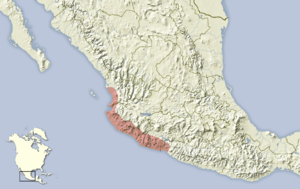Ring-tailed ground squirrel facts for kids
Quick facts for kids Ring-tailed ground squirrel |
|
|---|---|
| Conservation status | |
| Scientific classification | |
| Genus: |
Notocitellus
|
| Species: |
annulatus
|
| Synonyms | |
|
Spermophilus annulatus Audubon and Bachman, 1842 |
|
The ring-tailed ground squirrel (Notocitellus annulatus) is a type of rodent. It belongs to the Sciuridae family, which includes squirrels. You can only find it along the Pacific coast of central Mexico.
It's a common animal that mostly eats fruits and nuts. Experts say it's not in danger of disappearing. Because of this, it's listed as "least concern" by the IUCN.
Contents
What Does It Look Like?
This squirrel is about 38 to 47 centimeters (15 to 18.5 inches) long. Half of its length is just its tail! It's a bit smaller than the California ground squirrel. It also has thinner legs and wider, rounder ears.
Its front teeth (incisors) are orange. It has large cheek pouches that open inside its mouth. The top of its head and upper body are a mix of blackish-brown and buff colors. Its chin, throat, and belly are buff.
The tail is thin and not bushy. It's a mix of buff and black on top, and brownish underneath. It has about fifteen dark rings, which is how it got its name.
Where Does It Live?
The ring-tailed ground squirrel lives only in western Mexico. Its home range stretches from the State of Nayarit to the State of Guerrero. It prefers low-lying areas, usually below 1,200 meters (about 3,900 feet) high.
It can live in many different places. You might find it in forests with lots of vines. It also lives on open, rocky hillsides. These squirrels can even be found near farms. They like oil palm plantations where palm leaves cover the ground. They also live in mesquite scrub areas.
Their burrows are often in walls or dirt mounds. They might hide under spreading cacti or bushes. Sometimes, they even make their homes in holes inside trees.
How Does It Behave?
The ring-tailed ground squirrel eats corn and other seeds. But it mostly enjoys fruits and nuts. Its diet includes oil palm seeds, wild figs, and mesquite seeds. It also eats the juicy fruits of prickly pears. Sometimes, it even eats insects.
It mostly moves around on the ground. It scurries quickly from one hiding spot to another. Sometimes, it stops to dig up a tasty bite. Other times, it sits on its back legs to eat, holding food with its front paws. It can climb a few meters up small trees to get food from low branches.
If something scares it, the squirrel might quickly climb a tree. It will peek at what startled it, then hide behind the tree trunk. After that, it will climb down and run away to the nearest burrow. If it's scared in an open area, it might freeze still. Or it might run straight to its burrow. It often stops at the entrance to make a short whistle or chirping sound.
When it moves, it sometimes stops and stands tall on its back feet. It uses its tail to help it balance. When it runs, it holds its tail in a curve. It moves more gracefully and quickly than most other ground squirrels.
Reproduction
Ring-tailed ground squirrels have their babies during the dry season. This season lasts from December to June. One female squirrel was found to be carrying four baby squirrels (embryos).
Conservation Status
The ring-tailed ground squirrel is common in good habitats. Experts have not found any major threats to this animal. Because of this, the International Union for Conservation of Nature says its conservation status is "least concern". This means it is not currently in danger of disappearing.



